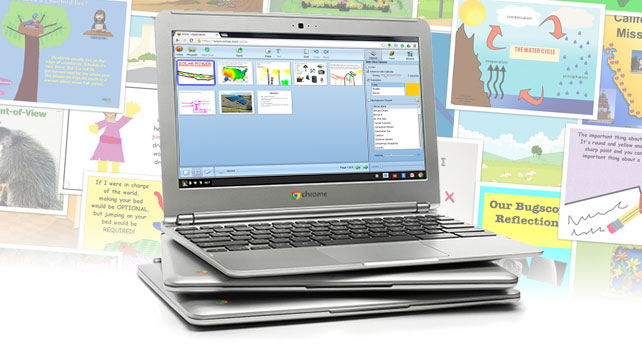

Today’s teachers face unique challenges never encountered—or even imagined—by their predecessors. Preparing students to thrive in a global, technologically advanced society where they must use digital tools that evolve at a blistering pace to succeed at careers that did not even exist a decade ago is a daunting task! Information processing skills have become a survival skill—nearly ubiquitous access to mountains of Web-based information may expose learners to more information in just one day than those of previous generations would have been able to access in a lifetime. In order to prepare students for their future, teachers must have the support and leadership of school administrators who understand 21st century skills.
To be effective leaders for the 21st century, administrators must ensure that instructional needs, the expertise of teachers, and the ultimate needs of students are considered. These 21st century administrators should be the facilitators of a dialogue that asks:

Achieving 21st century outcomes requires us to reconsider what and how we want students to learn. Much of the curriculum taught in U.S. classrooms today was designed in the late 1800s; many of the courses being taught right now have changed little in more than 100 years. Groups such as the Partnership for 21st Century Skills (P21) offer ideas and strategies for modifying core subjects to include 21st century themes, such as global literacy and environmental literacy, and recommend that we include skills like creativity and innovation, leadership and responsibility, and communication and collaboration in the discussion as we determine new academic outcomes.
Our 21st century administrators need to be effective instructional and technological leaders in their schools, actively participating in the selection and implementation of the tools teachers will use to engage students and improve learning. In the past, IT departments were tasked with making technology decisions, with much of the technology focus concerned with blocking access to inappropriate content. Effective selection of modern technology tools requires understanding of the instructional needs and goals of modern educators. 21st century administrators should expect teachers to demonstrate how tools like blogs, wikis, Google apps, Twitter, and other social networking and Web 2.0 technologies can be used to support students in meeting the expectations that have been set forth for a 21st century classroom.
We all chant the mantra of being “lifelong learners,” but professional development for many educators continues to be a hit-or-miss proposition, particularly when it comes to 21st century skills. Time and money are often cited as inhibiting factors to providing effective and sustained professional development, but these are just the obvious issues. We must look past the easy targets of financial and scheduling constraints to examine and hone the underlying paradigm we use as the cornerstone for our professional development efforts.
If yours is like most schools, professional development nearly always consists of trainings held on special days set aside throughout the school year. Topics may be chosen by the school staff, but often content is predetermined by someone at the district level. In some instances, professional development might also consist of attendance at a regional or national conference. Teachers may also be expected to enroll in upper-division courses at a local college or university. While there can be value in these activities, systemic change requires a fresh approach.
Effective professionals learn something new every day in both formal and informal settings. 21st century administrators need to create and support environments where staff members are encouraged to work collaboratively to share their expertise and learn from one another on a regular basis. Administrators can take the first steps toward this vision by modeling the behaviors they’d like to see teachers engaged in. Even if money and time are in short supply, there are actions we can take to improve professional practice. In his blog “Metanoia,” educator Ryan Bretag suggests five strategies for making professional development part of every day. They are:
As we explore the use and integration of new tools and strategies, how do we measure progress and success? Are tools being utilized to their fullest potential? Are students learning more? Or better? Are students more engaged? Evaluations must do more than measure score increases for the high-stakes tests. Effective evaluation must be capable of identifying student mastery of 21st century skills like collaboration, critical thinking and problem solving, creativity and innovation, research and information fluency, and digital citizenship. Evaluation should help us determine whether our efforts are helping students master content, think at higher levels, and become disciplined self-directed learners.
Intel and Edutopia provide some excellent online resources to help you develop school- and classroom-based assessments using strategies that measure student progress in both technology proficiency and the acquisition of 21st century skills.
To be successful in this endeavor, administrators can use several strategies to better prepare themselves and their staff to understand the impact these new tools can have.
In a recent workshop discussion about how we might foster collaboration in our classrooms, the topic of using blogs was raised. When we asked participants what they knew about blogs, the vast majority of those present agreed that they knew little or nothing about how blogs work or how they can be used to support instruction. Those very same participants, however, could describe in great detail the techniques their schools use to block access to blogs and other “objectionable” content. It is common to want to exclude what we don’t understand, but is it wise to prohibit access to the tools students regularly use away from school without exploring the potential they have for supporting and engaging learners?
Foster discussions between these two very important groups. Facilitate conversations that concern improving student performance rather than focusing on problems with providing access to some of these tools and applications.
Provide high-quality, concrete examples so teachers can see how these tools can support learning and explore how to integrate the technologies into their own teaching practice.
Show your staff that you are learning to integrate new technologies into your own practice as an instructional leader and a 21st century learner. Effective 21st century learning environments require educators to move from the role of “sage on the stage” to become facilitators of student learning. There’s no better way to encourage that risk-taking than leading by example.
Good things are already happening at your school. Celebrate them! But rather than simply raising the bar for everyone else, develop and cultivate opportunities for growth.
In April of 2007, Scott McLeod blogged on Dangerously Irrelevant, "Given the realities of our modern age and the demands of our children's future, is it really OK to allow teachers to choose whether or not they incorporate modern technologies into their instruction?" We encourage you to explore a similar sentiment as it applies to administrators. Given the realities of our modern age, is it OK if we choose not to develop strategies to incorporate 21st century skills and modern technologies to prepare our students for their future?
Project Tomorrow: Speak Up Reports

Follow us on Instagram for daily inspiration

Create a thought web, cluster, flowchart, or other graphic organizer for a lesson


Wixie
Share your ideas, imagination, and understanding through writing, art, voice, and video.

Rubric Maker
Create custom rubrics for your classroom.

Pics4Learning
A curated, copyright-friendly image library that is safe and free for education.

Wriddle
Write, record, and illustrate a sentence.
Topics